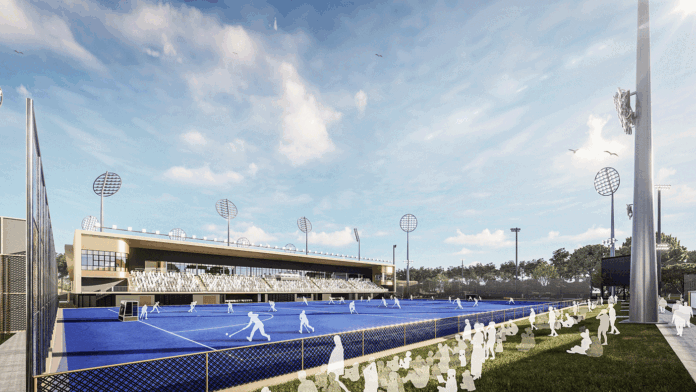Perth is set to score a major goal in Australia’s sporting landscape with the redevelopment of the hockey facility at Curtin University – a project that promises to combine world-class elite training with vibrant community engagement. The Western Australian Government’s recent funding top-up of US$28 million, lifting the total investment to US$163 million, underscores the State’s commitment to driving forward not only elite sport but also grassroots participation.
The new facility, destined to become the home of the Hockey Australia Centre of Excellence and the Hockey Australia High Performance Program, will be an impressive complex that bridges high-performance training and community sport. It will feature a specialist indoor hockey centre, four outdoor fields – including a dedicated pitch for children – and a main stadium that can accommodate up to 10,000 spectators in event mode. Along with modern broadcast capabilities designed to support live viewing and digital streaming, the facility is poised to bring some of the world’s best hockey talent to Perth while offering local players a platform to improve their skills.
Since Perth secured the bid to host Hockey Australia’s High Performance Program in December 2022, plans for the redevelopment have steadily evolved. The decision not only reaffirms Western Australia’s reputation as the nation’s hockey capital but also highlights a broader strategic approach to sports infrastructure. While previous WA investments such as the upgrades to HBF Park and major developments like Optus Stadium have drawn international acclaim, the hockey hub at Curtin University combines lessons learned from these projects with a unique twin focus on sporting excellence and community inclusiveness.
Historically, Western Australia has consistently placed emphasis on creating dual-use venues that serve elite athletes and the local community alike. The new hockey centre is being developed under the auspices of this philosophy, echoing strategies seen in other state developments such as the Netball Central project. The integration of a children’s playing pitch alongside high-performance training facilities speaks to a long-term vision where nurturing young talent sits side-by-side with showcasing world-class competition, ensuring a healthy pipeline for the sport’s future.
Economically, the redevelopment is anticipated to create significant ripple effects across the local community. Construction is expected to generate hundreds of direct jobs during the peak phases, while major sporting events held at the 10,000-seat stadium will likely attract visitors from interstate and overseas. Increased tourism and media exposure stemming from high-calibre competitions are projected to boost local businesses and potentially generate substantial annual revenues. In this climate of renewed investment, Western Australia is positioning itself to not only retain but also enhance its reputation as a hub for elite sport.
The project’s timeline reflects a pragmatic approach to minimising disruptions during the build. Already, upgrades on the northern pitch – including the installation of LED fittings and a new world cup quality surface replacing outdated halogen lights – have been completed ahead of the larger construction effort. This early work ensures that local clubs and community users continue to have access to top-level facilities throughout the development process, a vital consideration during a period when sport participation remains a key community priority.
The responsibility for managing the facility, once construction is complete, will be handed over to VenuesWest. The State-owned organisation, which also oversees venues such as RAC Arena and HBF Stadium, is expected to apply its considerable experience to balancing high-performance events with community needs. This management model, honed over years of running major sporting and entertainment complexes, promises to keep the facility running efficiently while continuing to drive community engagement and economic benefits.
The new hockey centre finds itself at an interesting historical and policy nexus. Western Australia’s Long-Term Sports Infrastructure Plan (2023–2033) has increasingly emphasised investments which support both elite and grassroots sport. The hockey facility, with its combination of a high-performance training centre and community pitches, fits neatly into this vision. Furthermore, by retaining Hockey Australia’s High Performance Program for the next 18 years, Perth joins a select group of cities that blend legacy with forward-thinking sports policy.
Yet, as with any major project, challenges and questions remain. Concerns have been raised about the environmental impact of constructing high-quality artificial turfs, noted in past evaluations as generating significant carbon emissions. Questions about the absence of a clear carbon offset plan have emerged from community observers and environmental groups. Moreover, while the addition of a new children’s pitch signals enhanced community engagement, some local clubs express apprehension over temporary disruptions during the main works. Traffic management, particularly concerning access upgrades on Roe Highway to cope with the surges in event-day crowds, is another issue that remains to be finalised. These challenges are not new to major Western Australian infrastructure projects, and planners are drawing on lessons from previous developments to work proactively with stakeholders and mitigate concerns.
In a broader international context, Perth’s move to invest in a state-of-the-art hockey facility is reminiscent of trends across continents where multi-use sports complexes serve both as elite training hubs and community sport venues. Cities in Europe and North America have long embraced dual-purpose designs that have boosted local interest and grassroots participation, a model that Western Australia adapts with its own local flavour. The decision to renew Perth’s association with Hockey Australia affirms the city’s status as an influential player in the world of field hockey, a statement that goes well beyond the boundaries of the sport itself.
As the Expression of Interest for the main works tender is set to be released shortly – with a contract award expected early next year and a projected completion by April 2029 – the coming years will see a sustained effort from government, industry, and community stakeholders alike to bring this ambitious vision to life. With modern technology, inclusive design, and a commitment to dual-purpose functionality, the new hockey facility at Curtin University is not merely a sports venue; it is a landmark development that reflects Western Australia’s dedication to sporting excellence, community wellbeing, and long-term strategic planning.
In many ways, the new facility encapsulates the essence of what sports development in Western Australia has come to mean in the 21st century. It is athletic ambition meeting community aspiration, challenging local teams to dream big while providing a stage for international competition. As construction commences and the vision moves steadily closer to reality, Perth and Western Australia can look forward to a future where the love of hockey is celebrated at every level, marking another significant stride in the State’s storied sporting history.

